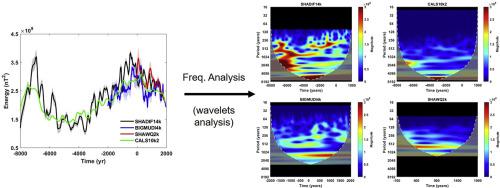Physics of the Earth and Planetary Interiors ( IF 2.4 ) Pub Date : 2021-01-31 , DOI: 10.1016/j.pepi.2021.106656 A. González-López , S.A. Campuzano , A. Molina-Cardín , F.J. Pavón-Carrasco , A. De Santis , M.L. Osete

|
The knowledge of the secular variation of the geomagnetic field at different time scales is important to determine the mechanisms that maintain the geomagnetic field and can help to establish constraints in dynamo theories. We have focused our study on the secular variation at millennial and centennial time scale searching for characteristic periods during the last 10 kyr. The frequency study was performed using four recent updated global paleomagnetic field reconstructions (SHA.DIF.14k, CALS10k.2, BIGMUDI4k and SHAWQ2k) by applying three techniques commonly used in signal analysis: the Fourier transform, the Empirical Mode Decomposition, and the wavelet analysis.
Short-term variability of the geomagnetic field energy shows recurrent periods of around 2000, 1000–1400, and 600–800 and 250–400 years. The characteristic time around 600–800 years is well determined in all paleomagnetic reconstructions and it is mostly related to the axial dipole and axial octupole terms, but also observable in the equatorial dipole. In addition to this period, longer characteristic times of around 1000–1400 years are found particularly in the equatorial dipole and quadrupole terms in SHA.DIF.14k, CALS10k.2 and BIGMUDI4k while the 2000 year period is only well determined in the total geomagnetic field energy of SHA.DIF.14k and CALS10k.2. The most detailed paleoreconstructions for younger times also detect shortest characteristic times of around 250–400 years.
The long-term variation of the geomagnetic energy is only observable in the axial dipole. A characteristic period of around 7000 years in both SHA.DIF.14k and CALS10k.2 has been found. This long period is related to two decays in the dipole field and a period of increasing intensity. The oldest decay took place between 7000 BCE and 4500 BCE and the present decay that started around 100 BCE. We have modeled the 4500 BCE up to present variation as a combination of a continuous decay, representing the diffusion term of the geomagnetic field, and one pulse that reinforces the strength of the field. Results show a characteristic diffusion time of around 11,000–15,000 years, which is compatible with the diffusion times of the dipole field used in geodynamo theories.
中文翻译:

全新世以来全球全新世地球磁场古生物变化的特征周期
了解不同时间尺度的地磁场的长期变化,对于确定维持地磁场并有助于建立发电机理论约束的机制非常重要。我们将研究重点放在千禧年和百年时间尺度上的长期变化,以寻找最近10年内的特征时期。频率研究是通过应用信号分析中常用的三种技术:傅立叶变换,经验模态分解和小波,使用四个最新更新的全局古磁场重构(SHA.DIF.14k,CALS10k.2,BIGMUDI4k和SHAWQ2k)进行的。分析。
地磁场能量的短期可变性显示出大约2000年,1000-1400年,600-800年和250-400年的重复周期。600-800年左右的特征时间在所有古磁重构中都得到了很好的确定,它主要与轴向偶极子和轴向八极子项有关,但在赤道偶极子中也可以观察到。除此期间外,在SHA.DIF.14k,CALS10k.2和BIGMUDI4k的赤道偶极子和四极子项中发现了更长的特征时间,大约为1000-1400年,而2000年的时间仅在总地磁中得到了很好的确定。 SHA.DIF.14k和CALS10k.2的场能。年轻时期最详细的古构造也可检测到约250-400年的最短特征时间。
地磁能量的长期变化只能在轴向偶极子中观察到。在SHA.DIF.14k和CALS10k.2中都发现了大约7000年的特征周期。这个较长的周期与偶极子场中的两个衰减以及强度增加的周期有关。最古老的衰减发生在公元前7000年至4500年之间,而目前的衰减始于公元前100年左右。我们已经对4500 BCE进行了建模,以将当前变化建模为一种连续衰减的组合,该衰减代表了地磁场的扩散项,而一个脉冲则增强了磁场的强度。结果表明,特征扩散时间约为11,000–15,000年,这与地球动力学理论中使用的偶极子场的扩散时间兼容。











































 京公网安备 11010802027423号
京公网安备 11010802027423号